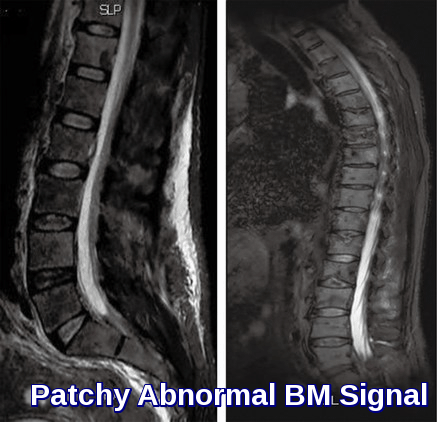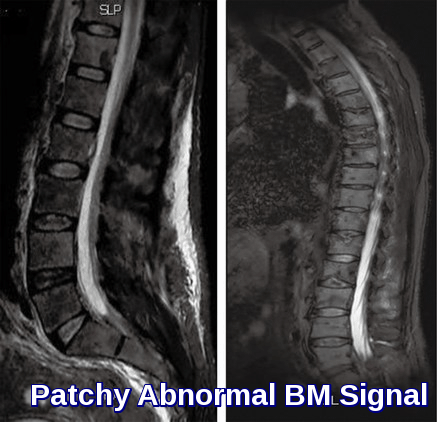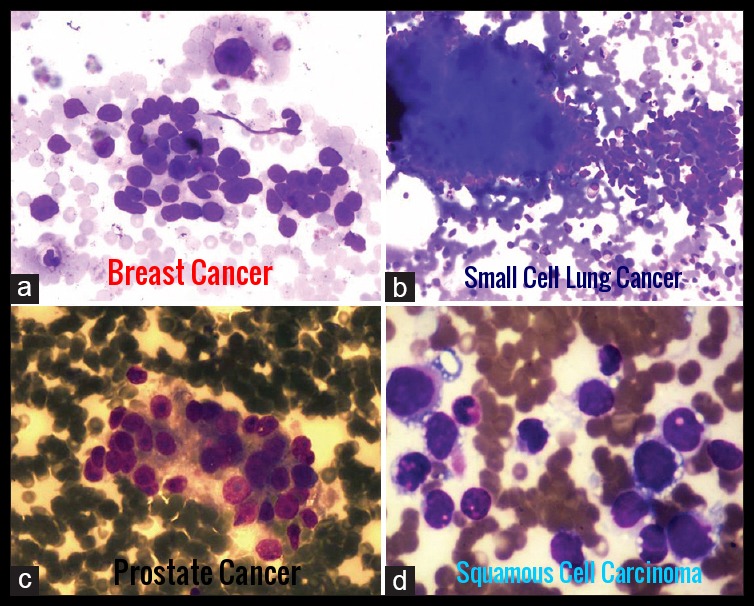Malignant Infiltration of Bone Marrow
Many cancers may infiltrate the bone marrow, most common are carcinoma of the lung, breast, prostate, colon, and thyroid.
In adults, malignant infiltration of bone marrow is most often seen in carcinomas of the prostate, breast, and lung, although any tumor that gives rise to blood borne metastases may infiltrate the marrow.
In children, malignant infiltration of bone marrow is most often seen in neuroblastoma, rhabdomyosarcoma, Ewing’s sarcoma, and retinoblastoma.
The bone marrow is one of the organs involved by tumors that metastasize via the blood stream.
Disseminated cells from primary solid tumors are considered to be the cause of metastases formation and relapse of disease. Consequently, their detection is of high importance for staging, prognosis, and decisions about adjuvant therapy.
In malignant infiltration of bone marrow, the blood count may be normal although pancytopenia may occur and there may be leukoerythroblastic blood picture. Malignant infiltration of bone marrow by the metastatic tumor may be focal or diffuse.
Malignant infiltration of bone marrow by the metastatic tumor may be focal or diffuse.
Bone marrow aspirates and trephine biopsies are sensitive techniques for detecting bone marrow infiltration. Marrow aspirates may be difficult because of fibrosis and trephine biopsies should also be performed.
Reticulin and collagen fibrosis are commonly present and are most marked in those cases with greater degrees of marrow infiltration. Marked fibrosis is most common in carcinomas of the breast, stomach, prostate, and lung.
Trephine biopsy is more sensitive than bone marrow aspiration and sensitivity is increased
by performing bilateral biopsies or by obtaining a single large biopsy and therefore these two procedures should be regarded as complementary. The two primary sites whose identification is most important because of their sensitivity to hormonal therapy are breast and prostate.
The detection of tumor cells in a trephine biopsy when none are demonstrable in smears of aspirate is not uncommon. However, occasionally tumor cells are seen in aspirate smears when trephine biopsy is normal.
The features of cancer cells include:
- A tendency to form clumps.
- High nuclear to cytoplasmic ratio.
- Nuclear moulding.
- Large prominent nucleoli.
Some tumors can be clearly identified by cytochemistry. Adenocarcinoma cells, for instance, may stain with mucin stains.
Other tumors can be very difficult to differentiate from hematological malignancies and cell marker studies may then be useful. The CD45 antigen is expressed on most hematological tumors but not other cancers.
Radiology:
The presence of lytic and blastic lesions on skeletal radiographic films is common in patients with prostate, lung, or breast cancer metastases.
Bone scans are sensitive for detecting bone metastases, while magnetic resonance imaging (MRI) scans of the involved area can detect marrow infiltration.
MRI can detect intramedullary infiltration in a highly advanced manner. It is also useful for the detection of tumor extension, associated soft tissue masses, and neurological compromise. MRI can increase the rate of successful bone marrow biopsies as it can assess a large volume of bone marrow noninvasively and relatively quickly.
Treatment:
Treat the underlying disease and provide supportive measures for symptomatic patients.
Prognosis:
In malignant infiltration of bone marrow, mortality is dependent on the underlying condition. The leukoerythroblastic blood picture is often associated with imminent death in some extreme cases. Patients with varying degrees of cytopenia are at risk for infection or bleeding.
References:
Brochamer WL Jr, Keeling MM. The bone marrow biopsy, osteoscan, and peripheral blood in non-hematopoietic cancer. Cancer. 1977 Aug. 40(2):836-40.
Delsol G, Guiu-Godfrin B, Guiu M, Pris J, Corberand J, Fabre J. Leukoerythroblastosis and cancer frequency, prognosis, and physiopathologic significance. Cancer. 1979 Sep. 44(3):1009-13.
Kaur G, Basu S, Kaur P, Sood T (2011) Metastatic Bone Marrow Tumors: Study of Nine Cases and Review of the Literature. J Blood Disord Transfus 2:110. doi: 10.4172/2155-9864.1000110 https://shar.es/1SLSar
Emmanuel C Besa, MD Myelophthisic Anemia: Background, Etiology, Epidemiology and Prognosis http://emedicine.medscape.com/article/204647-overview Accessed: November 2015.
Makoni SN, Laber DA. Clinical spectrum of myelophthisis in cancer patients. Am J Hematol. 2004 May. 76(1):92-3.
Robert C. Mellors Biological Characteristics of Benign and Malignant Neoplasms http://www.medpath.info/MainContent/Neoplasia/Neoplasia_02.html
Anner RM, Drewinko B (1977) Frequency and significance of bone marrow
involvement by metastatic solid tumors. Cancer 39: 1337-1344.
Savage RA, Hoffman GC, Shaker K (1978) Diagnostic problems involved in
detection of metastatic neoplasms by bone marrow aspirate compared with
needle biopsy. Am J Clin Pathol 70: 623-627.












Please what is the life span of a patient with a infiltration of malignant cell in bone marrow
Hi Cecilia,
I presume you are talking here about cancer spreading from an organ like the lung, breast, prostate, etc to the bone rather than cancers which originate from the bone marrow itself like leukemia/lymphoma/myeloma. The spine is the most common location of metastatic disease.
In general, patient survival is dramatically shortened once skeletal spread (metastases) are present.
For example, the 5-year overall survival rate for people with prostate cancer is 93%, but once skeletal metastases are present, the average survival time is only 29 months.
However, patients are surviving and remaining active for longer periods as treatment protocols improve.
Most patients with metastatic bone disease survive for 6-48 months.
Patients with breast and prostate carcinoma live longer than those with lung carcinoma.
Patients with renal cell or thyroid carcinoma have a variable life expectancy.
As the treatment protocols keep improving survival in turn improves.
You can read more about the prognosis and outcome of metastatic bone disease through this link.
Best wishes,
Thanks sir..May I ask about the expected marrow findings in patients with solid malignancies other than myelophthsis or fibrosis….The need for Immunohistochemistry(CD45,Cytokeratin )if the primary solid malignancy is already known..Finally ,The role of PET CT
Hi Sabry,
Thank you for your comment.
Certain solid tumors such as lung, breast, and prostate have the ability to spread to the bone marrow, resulting in the infiltration of tumor cells. This infiltration can manifest as either focal or diffuse, and it has the potential to impact normal hematopoietic cells, leading to conditions such as anemia, thrombocytopenia, and leukopenia.
In cases where the primary solid tumor is suspected, the diagnosis often necessitates bone marrow aspiration and biopsy for morphological evaluation, immunohistochemistry, and molecular studies.
Best regards,
Dr. M Abdou